| Pages:
1
2 |
quantumcorespacealchemyst
Banned Shitposter
Posts: 213
Registered: 17-10-2014
Member Is Offline
Mood: No Mood
|
|
the Permanganyl Ion MnO3+, salts and crystal systems
my prime concern is constructing novel/interesting Crystals out of/including this cation. i seek knowledge of how to work this ion into complex
crystal systems such as those found in nature, the complex ones but in a pure form and lab controlled to make giant single crystals. ie: http://www.mindat.org/min-3182.html (H3O)3KCa(UO2)7(PO4)4O4 · 8H2O
i don't mean that MnO3+ is found readily in nature, on this planet, i mean that complex systems inherrant to nature may be possible with this cation
if it were introduced into the formulation and so i seek how to engineer them.
please help me get information on salts/compounds that can be formed with the Permanganyl Ion MnO3+. preferably stable ones, and ones that can be
isolated.
i am assuming, hopefully incorrectly that the preservation of the MnO3+ cation is dependant on a concentrated solution of sulphuric acid.
then it seems that an insoluble salt would have to be made to be extracted/filtered and even then, dissolving in water may degrade it back to
permanganic acid or decompose to manganese oxide and oxygen or ozone
for reference on forum thread and backup data
"Mn2O7 can react further with sulfuric acid to give the remarkable cation MnO3+, which is isoelectronic with CrO3:[citation needed]
Mn2O7 + 2 H2SO4 → 2 [MnO3]+ + [HSO4]− + H2O
Mn2O7 decomposes near room temperature, explosively so at > 55 °C. The explosion can be initiated by striking the sample or by its exposure to
oxidizable organic compounds."
http://en.wikipedia.org/wiki/Manganese_heptoxide
originally starting from KMnO4 there will be KHSO4 in solution
"Mn2O7 arises as a dark green oil by the addition of concentrated H2SO4 to KMnO4. The reaction initially produces permanganic acid, HMnO4
(structurally, HOMnO3), which is dehydrated by sulfuric acid to form its anhydride, Mn2O7.
2 KMnO4 +(cold) 2 H2SO4 → Mn2O7 + H2O + 2 KHSO4 "
and assume starting from permanganic acid, HMnO4, is ideal to leave out potassium ions for some reactions although i guess that isolating Mn2O7 can
achieve this, but it will still probably have impurities, which cannot be washed out with water, as far as i know.
[Edited on 14-1-2015 by quantumcorespacealchemyst]
|
|
|
woelen
Super Administrator
        
Posts: 8014
Registered: 20-8-2005
Location: Netherlands
Member Is Offline
Mood: interested
|
|
Interesting subject. I do not think that H2SO4 is sufficient to make permanganyl, but I can imagine that oleum can do this. I actually have some oleum
(20% SO3 by weight, dissolved in H2SO4). I can take a little of this and add a tiny amount of finely powdered KmnO4 and see what happens. Maybe I get
some interesting color change. I have no idea what color the MnO3(+) ion has (if it exists at all). I'll come back on this tomorrow or next weekend.
Isolating MnO3(+) in one of its compounds certainly is beyond my capabilities.
|
|
|
chornedsnorkack
National Hazard
   
Posts: 563
Registered: 16-2-2012
Member Is Offline
Mood: No Mood
|
|
Quote: Originally posted by woelen  | Interesting subject. I do not think that H2SO4 is sufficient to make permanganyl, but I can imagine that oleum can do this. I actually have some oleum
(20% SO3 by weight, dissolved in H2SO4). I can take a little of this and add a tiny amount of finely powdered KmnO4 and see what happens. Maybe I get
some interesting color change. I have no idea what color the MnO3(+) ion has (if it exists at all). I'll come back on this tomorrow or next weekend.
Isolating MnO3(+) in one of its compounds certainly is beyond my capabilities. |
Ask the question this way: what is the solubility of Mn(VII) at various concentrations of H2SO4/H2S2O7? What is the colour of the solution (Oleum is
transparent and colourless)? And what is the condensed species in saturated solution?
At a certain concentration range, Mn2O7 precipitates as an immiscible liquid. But is there any concentration of oleum where the equilibrium solid
would be a permanganyl salt?
|
|
|
turd
National Hazard
   
Posts: 800
Registered: 5-3-2006
Member Is Offline
Mood: No Mood
|
|
I don't think that word means what you think it means: https://en.wikipedia.org/wiki/Crystal_system.
Do you perhaps mean crystal structure (https://en.wikipedia.org/wiki/Crystal_structure)?
Even then your post doesn't make much sense. What does it mean to work an ion into a crystal structure? Do you want to crystallize this ion?
Good luck, as few well defined Mn(VII) compounds have been isolated
c.f.: http://onlinelibrary.wiley.com/doi/10.1002/zaac.200600186/pd...
Have you even done a literature search?
[Edited on 15-1-2015 by turd]
|
|
|
woelen
Super Administrator
        
Posts: 8014
Registered: 20-8-2005
Location: Netherlands
Member Is Offline
Mood: interested
|
|
Quote: Originally posted by chornedsnorkack  | Ask the question this way: what is the solubility of Mn(VII) at various concentrations of H2SO4/H2S2O7? What is the colour of the solution (Oleum is
transparent and colourless)? And what is the condensed species in saturated solution?
At a certain concentration range, Mn2O7 precipitates as an immiscible liquid. But is there any concentration of oleum where the equilibrium solid
would be a permanganyl salt? |
Mn2O7 is soluble in H2SO4, its solutions are dark green. I can imagine that with SO3, this reacts with formation of SO4(2-) and MnO3(+) ions and maybe
these MnO3(+) ions in solution have a different color than Mn2O7 in solution.
Pure oleum is colorless and clear, like water. My 20% oleum indeed is clear like water. I also have a small amount of 65% oleum. That oleum has some
impurities, it is pale brown.
In contact with air, oleum gives of intensely dense white fumes, which are amazingly corrosive. These fumes are SO3, which reacts with water vapor in
air to form droplets of conc. H2SO4. It is not the nicest of compounds to play with 
|
|
|
chornedsnorkack
National Hazard
   
Posts: 563
Registered: 16-2-2012
Member Is Offline
Mood: No Mood
|
|
They can obviously be dark green only if they are dark and concentrated. Dilute solutions of Mn2O7 in concentrated H2SO4 cannot possibly be dark green
- they have to be something else, like light green.
On the other hand, dilute solutions of KMnO4 or HMnO4 in water or in dilute H2SO4 are not green - they are pink-violet.
Around which concentration of H2SO4 in water does the pink-violet colour of HMnO4 turn into green of MnO3+?
|
|
|
woelen
Super Administrator
        
Posts: 8014
Registered: 20-8-2005
Location: Netherlands
Member Is Offline
Mood: interested
|
|
I say that the solutions are dark green, because they are so. Even at low concentrations, the solutions are very intensely colored. Intense colors
also are observed with KMnO4, a very small amount already gives a strong color in water.
You need highly concentrated H2SO4 to observe the green color. Only little water is needed to lose the green color and get the usual purple color
again. I never measured the precise amount, but I have the impression that if you add only 10% or so of the volume of water to the solution in H2SO4,
then it becomes purple again.
Btw., I do not think that the green color is due to the presence of MnO3(+) ions. I think that the green color simply is the color of dissolved Mn2O7.
|
|
|
blargish
Hazard to Others
  
Posts: 166
Registered: 25-9-2013
Location: Canada
Member Is Offline
Mood: Mode Push
|
|
I have come across some sources that claim that when KMnO4 is added to excess concentrated H2SO4, the resultant
solution is a solution of permanganyl hydrogensulfate. They also state that the MnO3+ ion is green in solution. Attached is an
excerpt from Inorganic Chemistry by Holleman and Wiberg (2001)
I wonder if a similar effect could be achieved with perchloric acid to form a solution of permanganyl perchlorate. Now that seems like an exciting
compound 

BLaRgISH
|
|
|
woelen
Super Administrator
        
Posts: 8014
Registered: 20-8-2005
Location: Netherlands
Member Is Offline
Mood: interested
|
|
I tried the experiment of adding KMnO4 to oleum (20% SO3 by weight). In this experiment I added a tiny amount of KMnO4 (just a few mg) to appr. 1 ml
of oleum. This solution is dark green, but its color is more bright than the color of KMnO4 in normal conc. H2SO4 (the latter is more olive green).
The color of the solution is not stable. It slowly changes color from green to grey and after 10 minutes or so, the liquid is dark grey and also is
somewhat turbid.
When a drop of this dark grey liquid is added to water, then there is an impressive hissing noise and the resulting liquid is purple/red like a
solution of KMnO4, which has partially decomposed to hydrous MnO2. So, the SO3 does make a difference.
I indeed am inclined to think that green MnO3(+) is formed, but that this easily decomposes, one of the products being MnO2 or some sulfate of that in
the extreme liquid. With water, the remaining MnO3(+) gives permanganate ion again and the reddish color is caused by very finely dispersed hydrous
MnO2 which is brown/yellow at low concentrations.
Unfortunately I cannot try the experiment with HClO4. I only have 60% and 70% HClO4 and with these, KMnO4 just gives a purple solution.
[Edited on 15-1-15 by woelen]
|
|
|
deltaH
Dangerous source of unreferenced speculation
    
Posts: 1663
Registered: 30-9-2013
Location: South Africa
Member Is Offline
Mood: Heavily protonated
|
|
Quote: Originally posted by woelen  | ... products being MnO2 or some sulfate of that in the extreme liquid.
[Edited on 15-1-15 by woelen] |
or perhaps the MnO3+ is stripped of another oxygen to ???MnO2[3+]??? I've never heard of such a species though, so forgive my imagination...
|
|
|
woelen
Super Administrator
        
Posts: 8014
Registered: 20-8-2005
Location: Netherlands
Member Is Offline
Mood: interested
|
|
I do not think that another ion is formed. I saw that the liquid becomes turbid and i have the impression this turbidity was due to formation of very
small bubbles of oxygen, which only very slowly move to the surface, due to their small size and due to the high viscosity of the oleum.
It is a pity that I cannot do further research of this ion. It decomposes fairly quickly and the liquid in which it exists is so corrosive and heavily
fuming that it is impossible for me to isolate anything from it.
(A nice and impressive demo is to drip oleum on paper tissue. The paper tissue chars at once and starts smoking while producing a loud hissing noise.
Adding a drop results in complete charring in one second and the hissing and associated eating away of surrounding paper continues for a few more
seconds.)
[Edited on 15-1-15 by woelen]
|
|
|
deltaH
Dangerous source of unreferenced speculation
    
Posts: 1663
Registered: 30-9-2013
Location: South Africa
Member Is Offline
Mood: Heavily protonated
|
|
Quote: Originally posted by woelen  | I do not think that another ion is formed. I saw that the liquid becomes turbid and i have the impression this turbidity was due to formation of very
small bubbles of oxygen, which only very slowly move to the surface, due to their small size and due to the high viscosity of the oleum.
[Edited on 15-1-15 by woelen] |
Ah ok, now this is another matter  I was under the impression that it was a
transparent grey and not turbid. I was actually also about to ask if you observed any bubbles, but you pre-empted my question! I was under the impression that it was a
transparent grey and not turbid. I was actually also about to ask if you observed any bubbles, but you pre-empted my question!
Is it hypothetically possible that these bubbles contained ozone?
|
|
|
chornedsnorkack
National Hazard
   
Posts: 563
Registered: 16-2-2012
Member Is Offline
Mood: No Mood
|
|
Numbers for volatility I´ve encountered for oleum:
Boiling point:
Azeotropic concentration, 98,3 % acid - 330 degrees
100 % acid - 280 degrees
20 % SO3 - around 140 degrees
65 % SO3 - around 60 degrees
100 % SO3, liquid - 45 degrees, and also unstable to polymerization.
|
|
|
subsecret
Hazard to Others
  
Posts: 424
Registered: 8-6-2013
Location: NW SC, USA
Member Is Offline
Mood: Human Sadness - Julian Casablancas & the Voidz
|
|
Woelen, did you try adding the "fresh" permanganyl solution to water?
Fear is what you get when caution wasn't enough.
|
|
|
Molecular Manipulations
Hazard to Others
  
Posts: 447
Registered: 17-12-2014
Location: The Garden of Eden
Member Is Offline
Mood: High on forbidden fruit
|
|
Quote: Originally posted by woelen  |
When a drop of this dark grey liquid is added to water, then there is an impressive hissing noise and the resulting liquid is purple/red like a
solution of KMnO4, which has partially decomposed to hydrous MnO2. So, the SO3 does make a difference.
|
-The manipulator
We are all here on earth to help others; what on earth the others are here for I don't know. -W. H. Auden
|
|
|
chornedsnorkack
National Hazard
   
Posts: 563
Registered: 16-2-2012
Member Is Offline
Mood: No Mood
|
|
How long does the olive-green solution of permanganate in 100 % H2SO4 last? Does it bubble oxygen to turn gray?
|
|
|
woelen
Super Administrator
        
Posts: 8014
Registered: 20-8-2005
Location: Netherlands
Member Is Offline
Mood: interested
|
|
The olive-green solution in conc. H2SO4 (which is not 100% but somewhere between 96% and 98%, the rest being water) is stable. I kept it around for at
least an hour and the color does not change.
|
|
|
chornedsnorkack
National Hazard
   
Posts: 563
Registered: 16-2-2012
Member Is Offline
Mood: No Mood
|
|
If the olive-green of concentrated H2SO4 permanganate solution turns into violet already by 10 % dilution with water, it is to be expected that 70 %
perchloric acid also shows pink. 70 % perchloric acid is described as having Hammett H0 values around -7 - comparable to the acidity of 80 % H2SO4.
Found references at
https://books.google.ee/books?id=afkCAv3xwqQC&pg=PA43&am...
Is there any more reliable source than Google Books?
For H2SO4/H2O, the original source is quoted as Ryabova, 1966, table 2.1, page 37. Example values
80 % - -7,52
85 % - -8,29
90 % - -9,03
94 % - -9,59
96 % - -9,88
98 % - -10,27
99,0 % - -10,57
99,7 % - -11,01
99,9 % - -11,43
100,0% - - 11,94
For SO3/H2SO4, the original source is Vinnik, 1966, table 2.2, page 39. Again examples:
1,0 % - -12,43
2,0 % - -12,62
7,0 % - -13,04
10,0 % - -13,21
20,0 % - -13,62
36,0 % - -14,13
So... the H0 difference between 96 % H2SO4 and 20 % oleum is 3,74 units. Whereas the difference from 80 % to 96 % H2SO4 is 2,36 units.
[Edited on 16-1-2015 by chornedsnorkack]
|
|
|
quantumcorespacealchemyst
Banned Shitposter
Posts: 213
Registered: 17-10-2014
Member Is Offline
Mood: No Mood
|
|
i had originally started by putting a small piece of terbium in water and hoping to get terbium hydroxide. warm water i read to speeds this up, i
heated it and after a while realized the bubbles were most all nucleation. the outside tarnished and after days i decided to acidify it with 98%
sulphuric acid to get the sulphate. it sat to dissolve and i got back to it a few days later. after leaving that for a week or so i decided to add
some potassium permanganate (i forgot exact measurements) and some shavings of gold (fractions of a gram). on a hotplate after adding enough sulphuric
acid to be somewhere from 2-4times the amount of liquid from before. when the permanganate was added, it made nice looking purple swirls (stirbar)
which fizzed to clearness. it was heated moderatly and ceased when i felt it was far enough, having read that the heptoxide is form-able. there was no
green precipitate at the time if i recall correctly but it did form on standing overnight at least, if not before that after standing.
the flask had a rim of olive green moist precipitate, a banding of yellowy, slight olive plating/precipitate and olive with some brownish precipitate
collected on the bottom with the stir bar. funny enough, the slight powder of gold seems to have not dissolved, while earlier it had seemed to,
perhaps precipitated out.
around the time (at or after) starting the thread
i took pictures swirled it some and let it sit, and now most of the plating that was yellow seems to have fallen to the bottom and/or dissolved
the liquid was a light olive hue and seems the same now or somewhat darker but not by much.
while tentative to swirl the mix, i read that the explosive decomposition of manganese heptoxide is above 55degrees celcius and the flask has been at
lower than standard room temperature and in an absence of oxidizable material (besides possibly gold which would seem to be slowly ionized, and
moreover seems to be undissolved still)
photos
1,2 before swirling/letting sit overnight.
3,4 after settling overnight, swirling and settling for a few minutes.
5,6 after swirling and taking pictures of turbidity.
7 bottom view after settling a few minutes, gold colored powder/gold under olive/brown(slight). the bottom powder being denser, moves less with sway,
and doesn't disperse much [maybe a salt rather than gold])
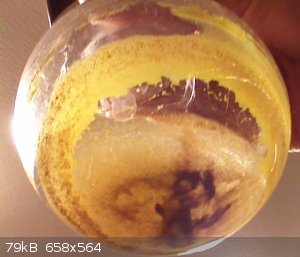 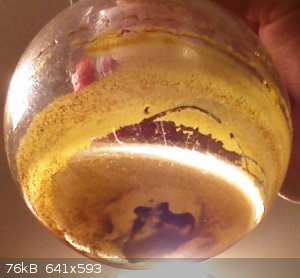 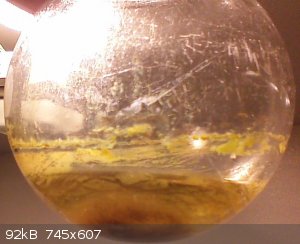 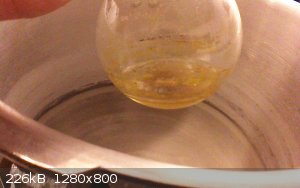 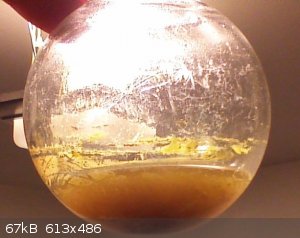 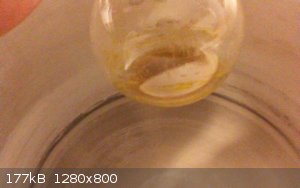 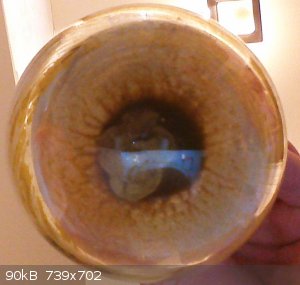
[Edited on 17-1-2015 by quantumcorespacealchemyst]
|
|
|
j_sum1
Administrator
       
Posts: 6324
Registered: 4-10-2014
Location: At home
Member Is Offline
Mood: Most of the ducks are in a row
|
|
I am reading but not understanding. What were you aiming to achieve by adding the gold? And how is this all related to the terbium?
|
|
|
quantumcorespacealchemyst
Banned Shitposter
Posts: 213
Registered: 17-10-2014
Member Is Offline
Mood: No Mood
|
|
 , yea, i had been trying to dissolve gold all sorts of unsuccessful ways.
i was originally intending to make terbium hydroxide, and neutralize HAuI4 with it, and did not end up with any success making
either. then i decided to turn the terbium to a sulphate, to see the cool florescence, i decided to see if a salt from permanganate or any more
interesting species might result that would also be fluorescent. figuring the gold might be able (a long shot) to make a complex salt, double salt. i
added the gold, figuring that with H2SO4 and KMnO4, it may dissolve. , yea, i had been trying to dissolve gold all sorts of unsuccessful ways.
i was originally intending to make terbium hydroxide, and neutralize HAuI4 with it, and did not end up with any success making
either. then i decided to turn the terbium to a sulphate, to see the cool florescence, i decided to see if a salt from permanganate or any more
interesting species might result that would also be fluorescent. figuring the gold might be able (a long shot) to make a complex salt, double salt. i
added the gold, figuring that with H2SO4 and KMnO4, it may dissolve.
i read that H2SO4 and KMnO4 dissolve gold together but not much more information besides that Mn2O7 can/does result. with a small amount, i figure it
may not precipitate as it would attach to gold hopefully. i also read that gold sulphate does not form as a salt, but can exist ionically. i believe
that was from looking into H2O2 and H2SO4. i actually didn't realize till much later that all my attempts with H2O2 were 3-5%, not 30% as i thought.
around 2007 i had used 30% ecover H2O2, it turns out now that bleach substitute is watered down/regular 3-5% seventh generation 7% ecover, H2O2. good
news for reformulation though
thank you all for the information so far. it turns out that MnO3Cl is not stable, and that MnO3F is not above 0°C. i don't know,
please help me comprehend this, if fluorine is the most electronegative anion and that is what governs the most of the attraction/bonding in an ionic
compound/salt such as MnO3+ F-. i also don't understand what, if possible with a ionic species, makes it possible to get past the valance electrons
and to be covalent/stronger bonded. i mean i don't understand the orbitals and if/how they can be shuffled/edited/tweaked.
as far as the MnO3F, i read that it is stable under reflux (temperature not mentioned) in IF5
quoting Inorganic Reactions and Methods, The Formation of Bonds to Halogens, Part 2
(edited?) By J. J. Zuckerman
https://books.google.com/books?id=OcD4P1ZeXdAC&pg=PA274&...
"interestingly, MnO3F is stable under IF5 solution under reflux"
full related quote > "Permanganyl flouride, MnO3F, is unstable above 0°C but can be prepared^[63] by reacting KMnO4 with either
HSO3F or HF;
KMnO4 + 2HF ---> MnO3F + KF + H2O (m)
KMnO4 + 2HSO3F ---> MnO3F + KSO3F + H2SO4 (n)
In addition to using HSO3F or HF, IF5 may be used^[64] ; interestingly, MnO3F is stable under IF5 solution under reflux. In all
preparations the MnO3F needs to be further purified by vacuum distillation; if HF is present then a second treatment is needed using xs KMnO4 or KF,
which reacts with the HF to form MnO3F or KHF2, respectively^[63]."
[Edited on 17-1-2015 by quantumcorespacealchemyst]
[Edited on 17-1-2015 by quantumcorespacealchemyst]
|
|
|
quantumcorespacealchemyst
Banned Shitposter
Posts: 213
Registered: 17-10-2014
Member Is Offline
Mood: No Mood
|
|
i just realized that the equation from wikipedia seems to be incorrect
http://en.wikipedia.org/wiki/Manganese_heptoxide
"Mn2O7 can react further with sulfuric acid to give the remarkable cation MnO3+, which is isoelectronic with CrO3:[citation needed]
Mn2O7 + 2 H2SO4 → 2 [MnO3]+ [HSO4]− + H2O "
Mn2O7 + 2H2SO4 ---> 2[MnO3]+ + 2[SO4]-2 + H2O doesn't charge balance
Mn2O7 + H2SO4 ---> 2[MnO3]+ + [SO4]-2 + H2O seems to work
since MnO3 does that bridge mechanism, with the O3Mn-O-MnO3
and sulphuric acid can form to oleum> pyrosulphuric/disulphuric acid
with HO3S-O-SO3H,
do you think, assuming water is removable somehow from formation of permangany, that they can trade endings forming two O3Mn-O-SO3H ?
reconfiguring with pyrosulphuric acid in the formula,
Mn2O7 + H2S2O7 ---> 2H2SMnO7 ?
O3Mn-O-MnO3 + HO3S-O-SO3H ---> HO3S-O-MnO3 + O3Mn-O-SO3H
|
|
|
chornedsnorkack
National Hazard
   
Posts: 563
Registered: 16-2-2012
Member Is Offline
Mood: No Mood
|
|
How is this incorrect?
It balances. Does not mean it works. HSO4- is much weaker acid than H2SO4.
Quote: Originally posted by quantumcorespacealchemyst  |
since MnO3 does that bridge mechanism, with the O3Mn-O-MnO3
and sulphuric acid can form to oleum> pyrosulphuric/disulphuric acid
with HO3S-O-SO3H,
do you think, assuming water is removable somehow from formation of permangany, that they can trade endings forming two O3Mn-O-SO3H ?
|
Yes. MnO3+HSO4-. The question is then only, how far is permanganyl hydrogen sulphate an ion pair, and how far it is covalently bonded.
Are the olive green solutions of permanganate in sulphuric acid solutions of MnO3+ cation, or solutions of molecular and undissociated Mn2O7? When
that olive green solution is electrolyzed, does Mn travel to anode (as MnO4-), or cathode (as MnO3+), or does it remain stationary as undissociated
Mn2O7 while H2SO4 alone is electrolyzed (as HSO4- on anode and H3SO4+ on cathode)?
That one does not balance hydrogens. Permanganyl hydrogen sulphate is HMnSO7, not H2MnSO7.
|
|
|
quantumcorespacealchemyst
Banned Shitposter
Posts: 213
Registered: 17-10-2014
Member Is Offline
Mood: No Mood
|
|
No, the first one, its 2H2SO4 but there is only 1HSO4- and H2O. leaving
4 hydrogens on the left, 3 on the right
that equation is from Wikipedia and needs correction. I don't know the correct mechanism.
You are right about permanganyl hydrogen sulphate being HSMnO7 H2SMnO7
And thanks for the tip on analysis by electrolysis. Do you know if these ions are stable to current? I am guessing platinum or iridium electrodes are
ideal.
Furthermore, I forgot before that the gold was minimal dust left over from experiments, I dumped it in after adding the KMnO4 to the sulphuric acid,
terbium sulphate, as it was left over and to light to weigh on the milligram balance.
I recovered it with some powder and realized again how little there was.
In most, the step was probably a 50:50 ratio of 98% H2SO4 to water with a little, maybe .6g terbium added, later 1/2 to 2/3 H2SO4 by volume added and
then about .5-1g KMnO4.
The step I did yesterday was take a mystery liquid, please take this seriously, and add it with precaution, outside with a snow bath. i will describe
the liquid below. It turned color to partly darkish amber and overnight turned darker amber. all precipitate dissolved save for the gold dust (I
assume most to all gold recovery) and some grains of something I don't know.
I had originally attempted dissolving silver in the liquid prior to addition of the mystery liquid. the silver was caked woth some grains which seemed
to leave intact after decanting to remove the silver.
the mystery liquid was originally around 50ml of 3-5% H2O2. into it was bubbled the HCl gas produced by reacting 1.68g 1,4-dibromobenzene with
>/~1ml CH3COCl, (1.318g AlCl3, 3.5hrs).
a bit of acetyl chloride efficient condensing and the volatile oil produced (assuming 1,4-dibromoacetophenone).
nonetheless, the actual liquid seems to have been HCl. the H2O2 being exhausted to send Cl2 to NaOH solution dissolving in remaining water and
dehydration over time leaving concentrated solution which decomposed sodium hydrogen carbonate. solution was partly cloudy maybe due to acetyl
chloride and or 1,4 dibromoacetophenone contamination.
it is all dissolved though, all the green KMnO7 is dissolved it seems
[Edited on 25-1-2015 by quantumcorespacealchemyst]
|
|
|
quantumcorespacealchemyst
Banned Shitposter
Posts: 213
Registered: 17-10-2014
Member Is Offline
Mood: No Mood
|
|
this stuff is really dark now.
[Edited on 26-1-2015 by quantumcorespacealchemyst]
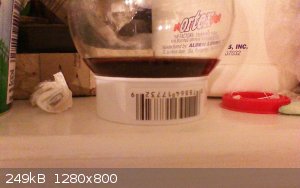
|
|
|
| Pages:
1
2 |